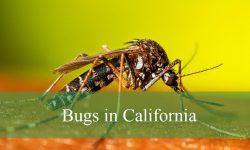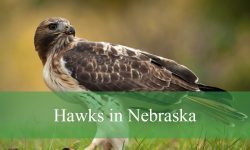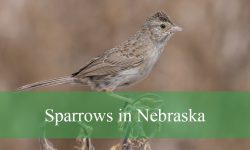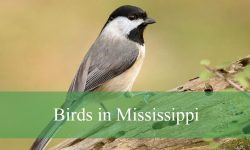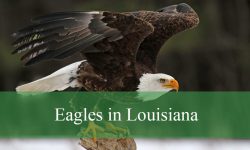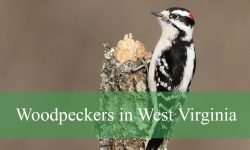Kansas State Birds are a testament to the state’s rich biodiversity, offering a delightful array of colors, shapes, and sounds. From the graceful flight of the Eastern Meadowlark to the vibrant plumage of the Indigo Bunting, each bird adds its own unique charm to Kansas’s landscape.
Whether soaring high above the prairies or flitting among the trees, these avian residents enrich the natural tapestry of Kansas with their presence. Let’s explore the fascinating world of Kansas State Birds and marvel at the wonders they bring to our skies.
Different Types of Kansas State Birds
Northern Cardinal
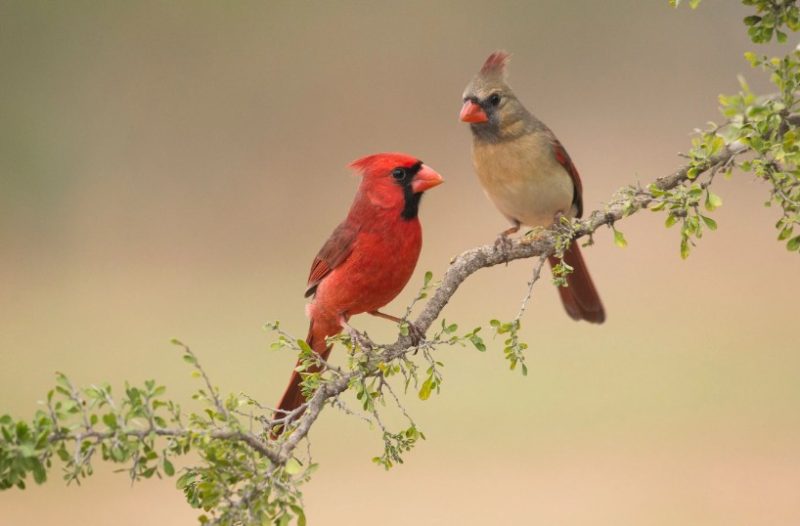
The Northern Cardinal (Cardinalis cardinalis) is a medium-sized songbird, measuring 8.75 inches in length, weighing 1.6 ounces, and with a 12-inch wingspan. Recognizable by their perky crest and bright orange-red beak, males are vivid red with a black face and throat, while females are grayish-brown with red highlights. Their song includes a distinct “pichew-pichew-pichew, chew, chew, chew, chew.” Common in Kansas, they love black-oil sunflower seeds at feeders.
Blue Jay
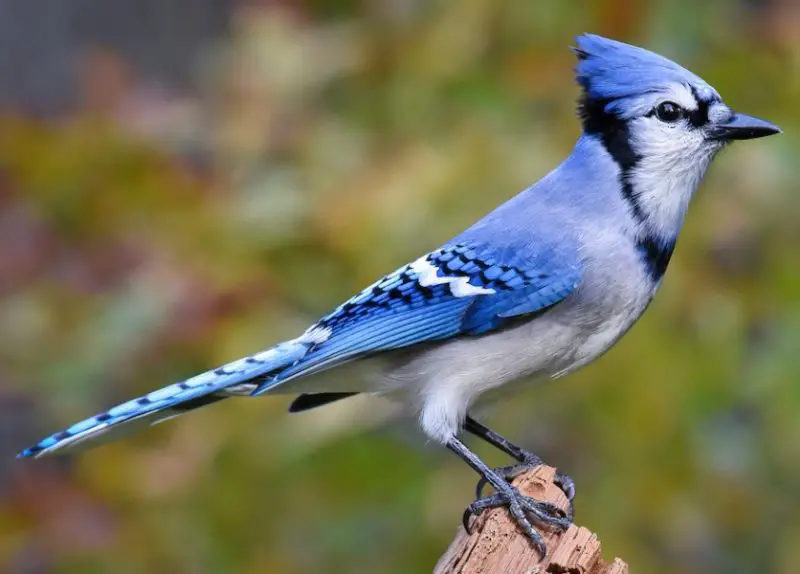
The Blue Jay (Cyanocitta cristata) is a fairly large bird, measuring 11 inches in length, weighing 3 ounces, with a 16-inch wingspan. It has a crest, straight black bill, blue upperparts, and gray-white underparts. Notable features include white cheeks, black facial lines, and a narrow black necklace. Blue Jays make messy cup nests in trees and feed on acorns, nuts, insects, and more. Their call is a nasal “Nyeah! Nyeah! Nyeah!”
American Robin
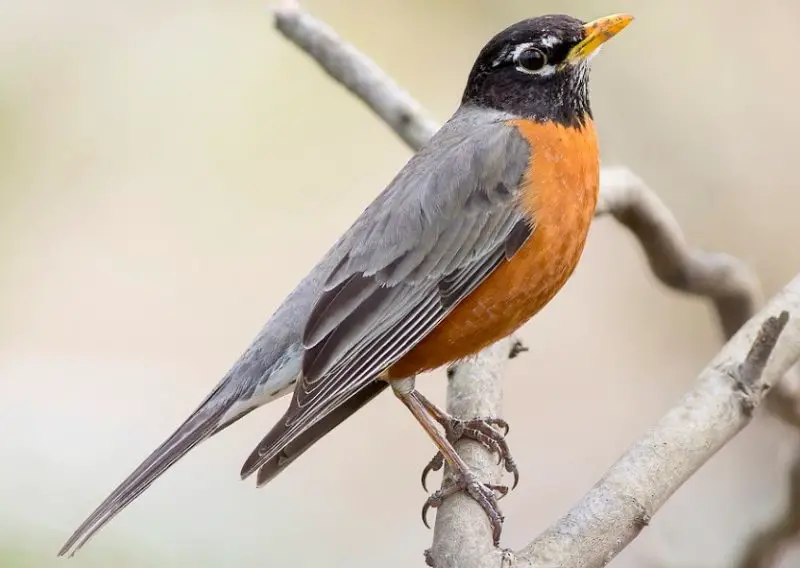
The American Robin (Turdus migratorius) is a familiar thrush, 10 inches long, weighing 2.7 ounces, with a 17-inch wingspan. It is dark gray above and brick red below, featuring an orange-yellow bill and white eye markings. Both sexes are similar, but males are darker. In flight, they show white tail corners. Robins forage on the ground for worms and insects and flock to eat berries in winter. Their song is a cheerful “cheery, cheery, cheery, cheery, cheer, cheer.”
Mourning Dove
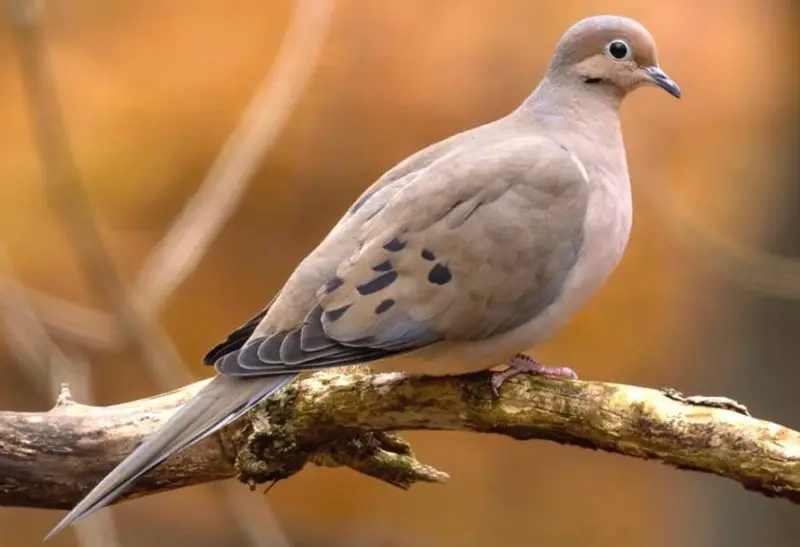
The Mourning Dove (Zenaida macroura) is a medium-sized dove, 12 inches long, weighing 4.2 ounces, with an 18-inch wingspan. It has a grayish-brown body, long tail, small black wing spots, and slender dark beak. Both sexes have gray eyerings and a black facial mark, with males showing more gray and iridescence. Known for its “hooOOA, hoo, hoo, hoo” song, this dove forages on seeds and grains, often visiting feeders and building messy stick nests in trees.
Black-capped Chickadee
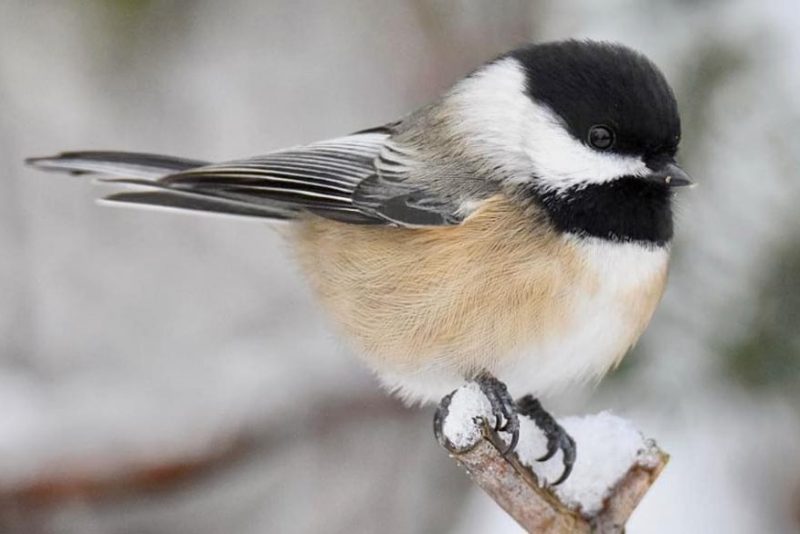
The Black-capped Chickadee (Poecile atricapilla) is a small bird, 5.25 inches long, weighing 0.39 ounces, with an 8-inch wingspan. It has a black cap, black throat, white face, and a stubby black beak. Both sexes look alike. They forage for insects, seeds, and fruit, often hanging upside down from twigs. These birds nest in tree cavities and visit feeders frequently. Their song is a whistled “see bee, see bee.”
American Crow
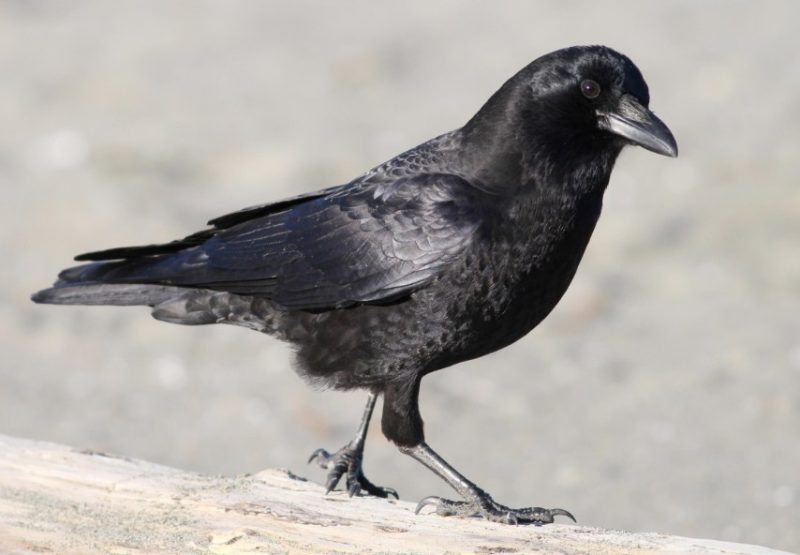
The American Crow (Corvus brachyrhynchos) is a large, all-black bird, 17.5 inches long, weighing 1 pound, with a 39-inch wingspan. It has a strong, stout bill and iridescent purple and blue hues in certain light. Both sexes look alike, featuring long, broad wings, and a broad tail. Known for their “Caw! Caw!” call, these intelligent birds forage in flocks, eating carrion, fruit, seeds, insects, and small animals. They build bulky stick nests high in trees.
Red-bellied Woodpecker
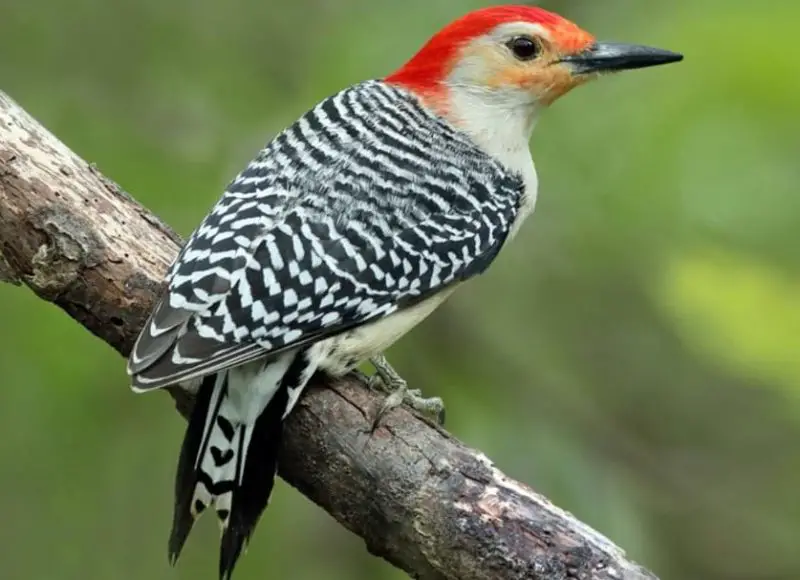
The Red-bellied Woodpecker (Melanerpes carolinus) is a medium-sized bird, 9.25 inches long, weighing 2.2 ounces, with a 16-inch wingspan. It has black and white barring on its back and wings, pale gray underparts, and a small red patch on the belly. Males have red from bill to nape, while females have an orange-red spot above the bill and red on the nape. They forage for seeds, nuts, and insects, and nest in tree cavities. Their call is a loud “Qwerr!”
Downy Woodpecker
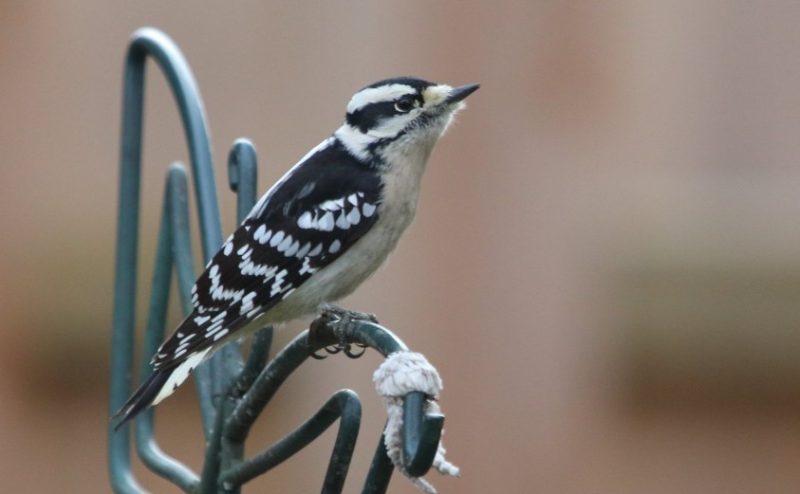
The Downy Woodpecker (Dryobates pubescens) is a small bird, 6.75 inches long, weighing 0.95 ounces, with a 12-inch wingspan. It has a black and white pattern, with males sporting a red patch on the back of their head. This species has a short black beak and a white tuft at its base. They forage for insects, seeds, and suet, and nest in tree cavities. Their calls include a sharp “Pik!” and a trilled “Ch,ch,ch,ch,ch,ch,ch!”
House Finch
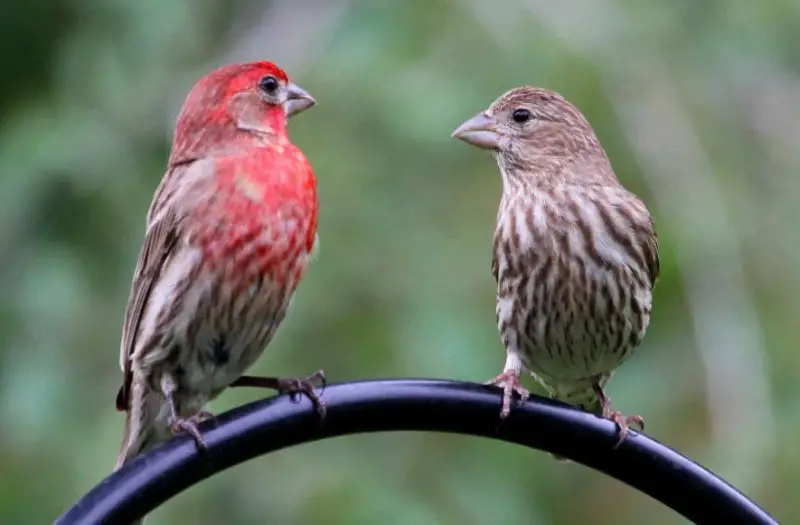
The House Finch (Haemorhous mexicanus) is a sparrow-sized bird, 6 inches long, weighing 0.88 ounces, with a 10-inch wingspan. Males are orange-red or rose-red on the head, throat, and breast, with brown streaks on their back and flanks. Females are streaked gray-brown without red. They feed on seeds, buds, fruit, and flowers, often visiting feeders. Their song is a warbling “chip,chip,chiprididip,ZREEYachip.” They nest in trees, building ledges, and similar spots.
American Goldfinch
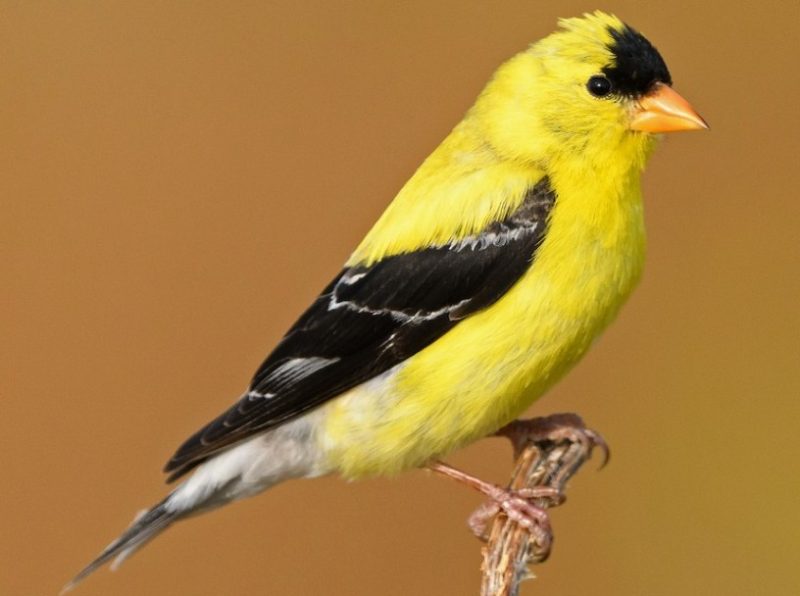
The American Goldfinch (Carduelis tristis) is a small finch, 5 inches long, weighing 0.46 ounces, with a 9-inch wingspan. Summer males are bright lemon yellow with a black cap and black wings, while females and winter birds are gray, buff, and yellowish with two pale wing bars. They feed on seeds from low plants and trees and visit feeders. Their song is “swit sweet, sipsipsipchichisweetsweet.” They build tightly woven cup nests high in shrubs or low trees.
European Starling
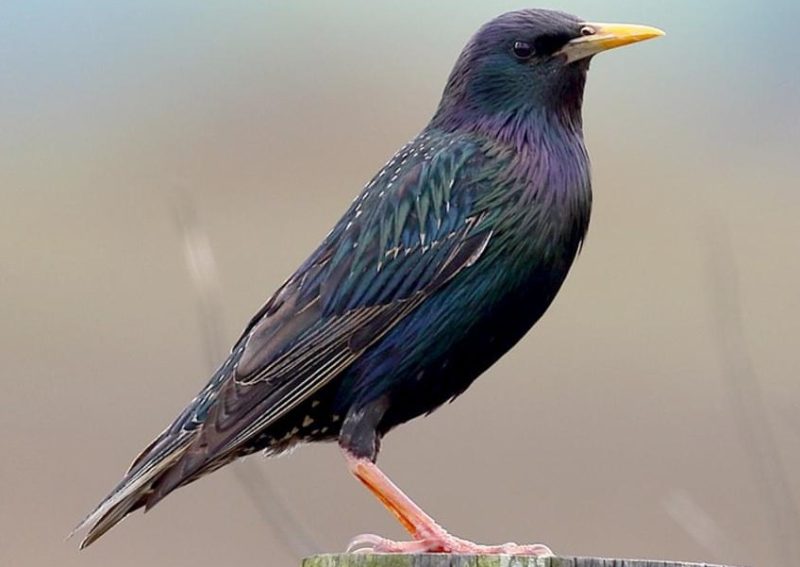
The European Starling (Sturnus vulgaris) is a plump bird, 8.5 inches long, weighing 2.9 ounces, with a 16-inch wingspan. In summer, they have glossy black plumage with purple and green highlights, yellow beaks, and white spots. Males and females are similar, but males are glossier. In winter, they have more white spots and black beaks. They feed on insects, fruit, and seeds, and build soft cup nests in cavities. Their song is a jumbled “tiktiktitZHREEree..tiktiktik..ZHREE”.
Canada Goose
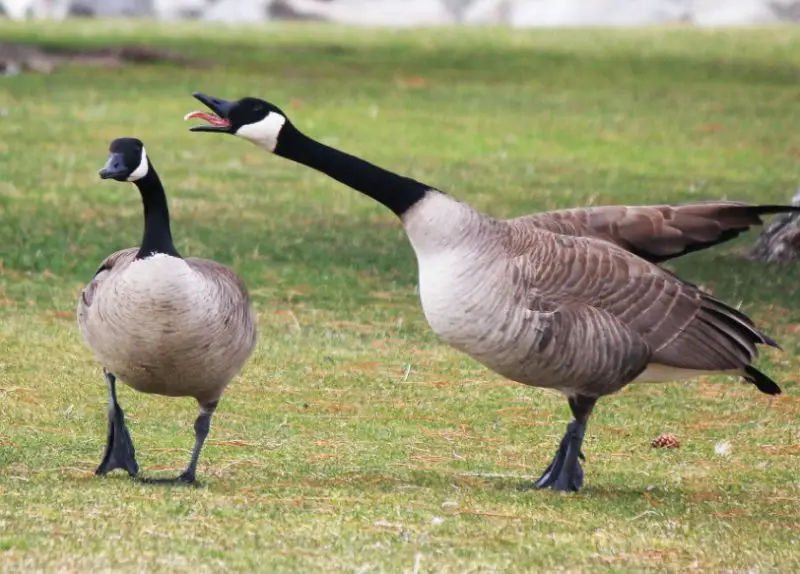
The Canada Goose (Branta canadensis) is a large bird, varying in length from 35 to 45.2 inches, weighing between 5.29 to 19.8 pounds, with a wingspan of 50 to 67 inches. It has a grayish-brown body, long black neck, and black head with white throat and cheeks. Both sexes look alike, with pale barring, a white belly and undertail, and a short black and white tail. Their song is a honking “uurrRUNK! uurrRUNK!”
Tufted Titmouse
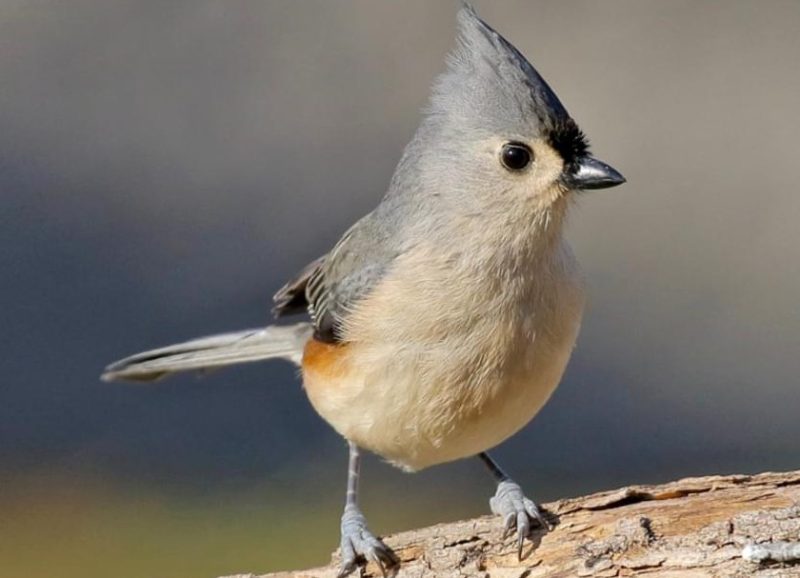
The Tufted Titmouse (Baeolophus bicolor) is a small, crested bird, 6.5 inches long, weighing 0.75 ounces, with a 9.75-inch wingspan. It has a blue-gray body, white face, and peach-orange flanks. Males and females look alike, with a small black mark above their stubby black beak. They forage in small groups for insects and seeds in woodlands and parks, and often visit bird feeders. Their song is a repetitive “peter peter peter”.
House Sparrow
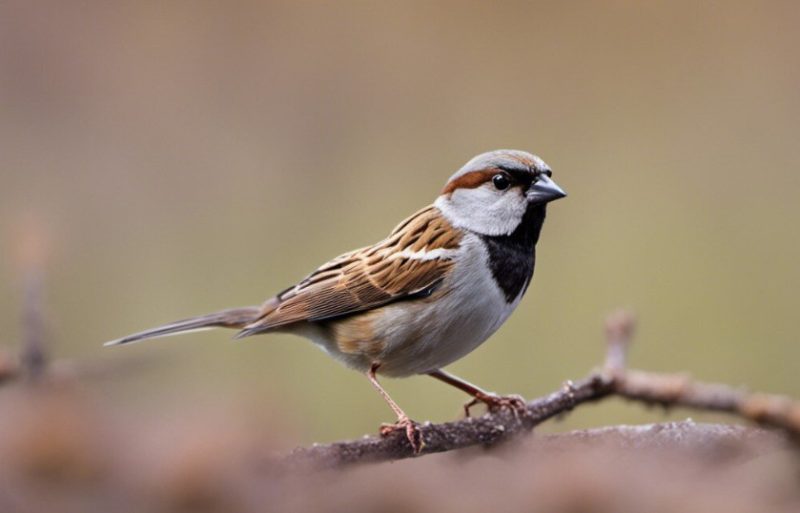
In the Atlantic rainforest of southeast Brazil, a House Sparrow (Passer domesticus) perches on a branch. This small bird measures 6.25 inches in length, weighing 0.98 ounces, with a wingspan of 9.5 inches. It has a plump gray and brown body, with males featuring a gray and rufous head and black markings near their eyes and throat. Their song is a friendly series of chirping sounds, “see,chirrup,see,chirrup,see,chirrup”.
Dark-eyed Junco
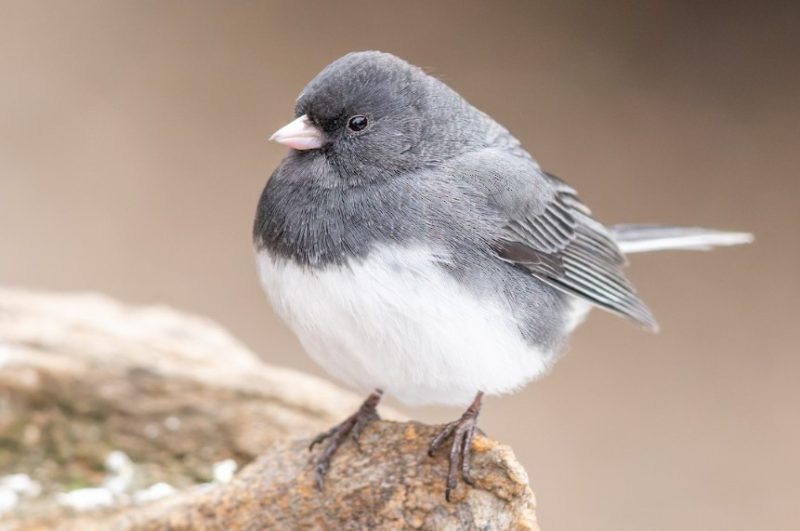
The Dark-eyed Junco (Junco hyemalis) is a sparrow-like bird measuring 6.25 inches in length, weighing 0.67 ounces, with a wingspan of 9.25 inches. It has a pale conical bill and dark eyes. Most juncos display slate gray or gray and brown plumage with white bellies and under their tails. They forage on the ground for seeds and insects in wooded areas and parks, often forming flocks during the non-breeding season. Their song is a short, plain trill, “sipsipsipsipsipsipsip”.
Red-winged Blackbird
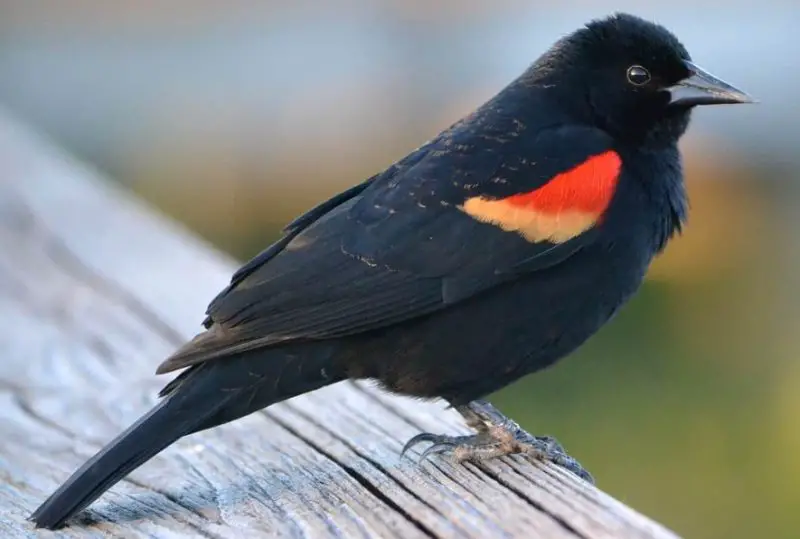
The Red-winged Blackbird (Agelaius phoeniceus) is a medium-sized blackbird, measuring 8.75 inches in length, weighing 1.8 ounces, with a wingspan of 13 inches. Males sport a scarlet patch bordered by pale yellow on their wings, while females are streaked brownish-gray with an orange-buff eyebrow and throat. They feed on seeds, grain, and insects in open habitats, often forming large flocks. Their loud song is a distinctive “kan-keree!”, accompanied by “check!” calls and a high-pitched whistle.
Carolina Wren
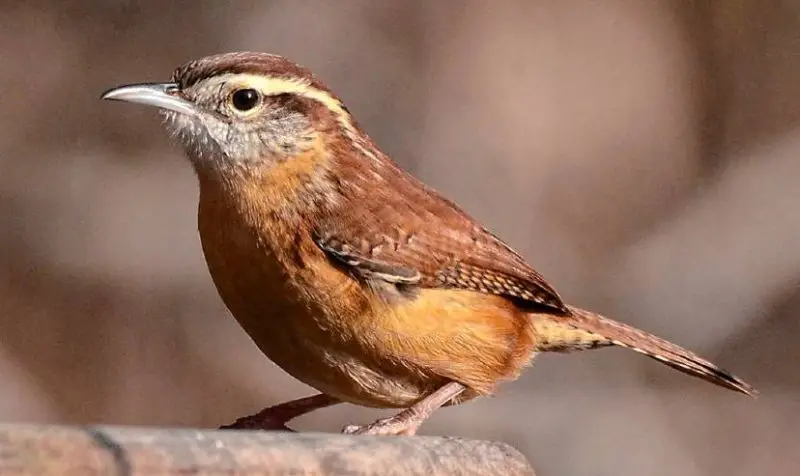
The Carolina Wren (Thryothorus ludovicianus) is a petite bird, measuring 5.5 inches long and weighing .74 ounces, with a wingspan of 7.5 inches. It boasts reddish-brown and buff plumage, a long, sharp beak, and a distinctive white eyebrow. This animated bird forages for insects in dense vegetation, often occurring in pairs. They construct cup nests in cavities of stumps, bushes, or even potted plants. Their melodious song, including the familiar “teakettle, teakettle, teakettle”, fills gardens and parks in the eastern USA and parts of Mexico.
Northern Flicker

The Northern Flicker (Colaptes auratus), Alabama’s state bird, is a sizable woodpecker, measuring 12.5 inches long and weighing 4.6 ounces, with a wingspan of 20 inches. Sporting tan and gray plumage, they exhibit black barring on their backs and have a distinctive black mark on their breast.
Males in the east sport a tawny throat and face with a black moustache, while western males have mostly gray heads. These vocal birds emit loud calls, including a repeated “kick,kick,kik,kik,kik.kik.kik.kik.kik.kik.kik.kik!” as they forage for ants and insects on the ground in wooded and open habitats throughout Canada, the USA, and Mexico.
Red-Tailed Hawk
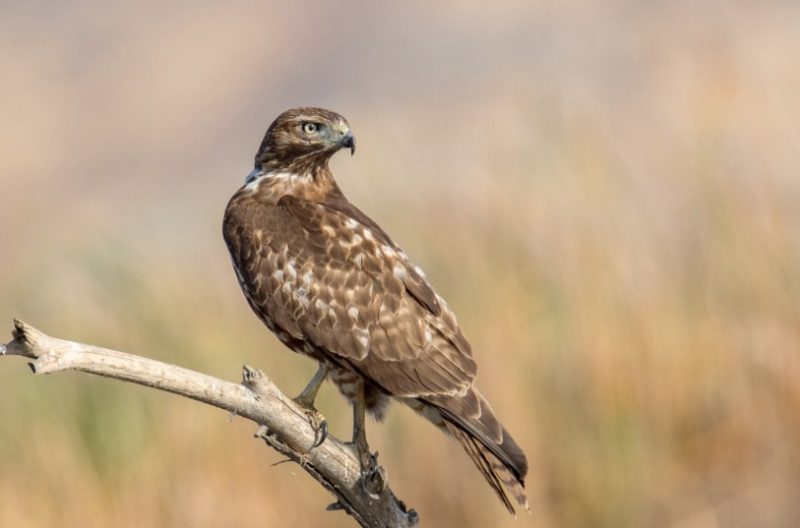
The Red-tailed Hawk (Buteo jamaicensis) is a substantial raptor, measuring 19 inches in length and weighing 2.4 pounds, with an impressive wingspan of 49 inches. Identified by its broad, orange or reddish tail, this hawk boasts dark brown plumage above and pale undersides adorned with dark markings. While soaring, it emits its distinctive call, a loud “Kreeeyahh!” Often found in woodlands near open areas, it builds large stick nests high in trees and preys on small animals like squirrels and rats.
Turkey Vulture
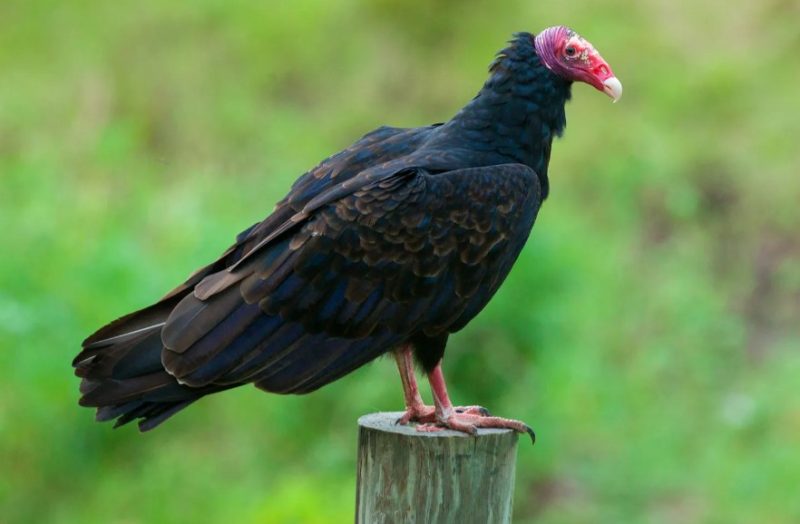
The Turkey Vulture (Cathartes aura) is a sizable raptor, measuring 26 inches in length and weighing 4 pounds, with an impressive wingspan of 67 inches. Identified by its dark brownish-black plumage, small red head, and long, broad wings, both males and females share these characteristics.
This scavenger primarily feeds on carrion and can be observed soaring with its wings in a distinctive “V” shape. Turkey Vultures nest on the ground in secluded areas and are commonly found across a wide range of habitats. They emit hissing sounds rather than typical bird calls.
Great Blue Heron
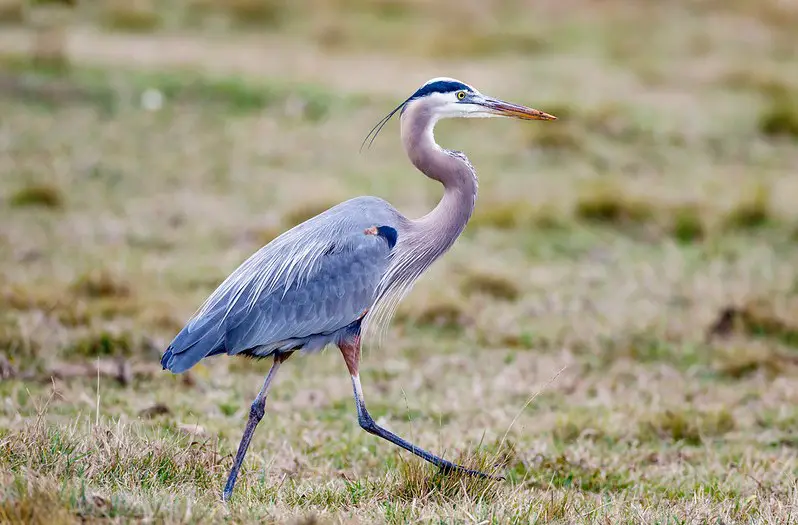
The Great Blue Heron (Ardea herodias) is a large, gray and pale brown wading bird with a length of 46 inches, weight of 5.3 pounds, and wingspan of 72 inches. It has a long neck, legs, and a strong yellowish beak. This heron features a black and white head with a wispy black crest and rufous thighs. It feeds on fish and small animals. In flight, it makes slow, deep flaps with its broad gray and black wings. These birds build messy stick nests and breed in colonies, often in swamps, emitting a “Grunk! Grunk!” sound when taking flight.
White-breasted Nuthatch
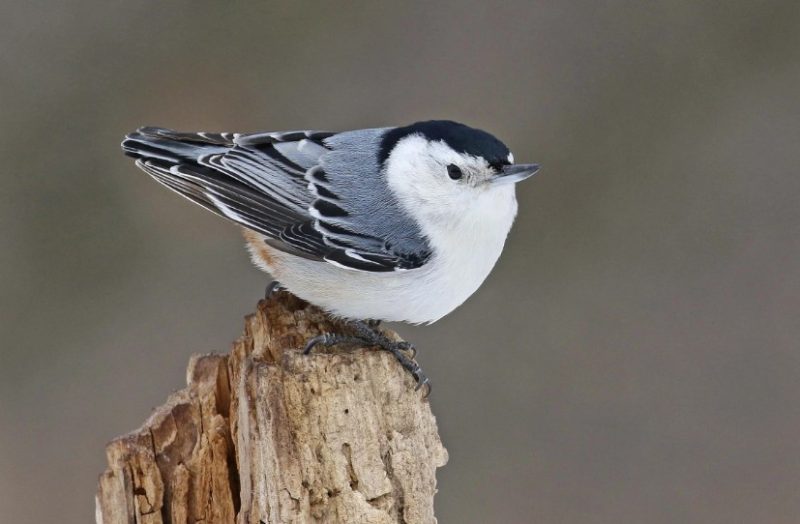
The White-breasted Nuthatch (Sitta carolinensis) is a sparrow-sized bird, 5.75 inches long, weighing 0.74 ounces, with an 11-inch wingspan. It has a longish, sharp, slightly upturned beak and a short black and white tail. Blue-gray above and white below with some chestnut on its belly and undertail, males have a black cap and nape while females have gray.
This bird forages for insects, nuts, and seeds by creeping along branches and tree trunks, often visiting feeders. It nests in tree cavities or nest boxes. Its song is a nasal, laughter-like “wehn wehn wehn wehn wehn wehn wehn wehn”.
Mallard
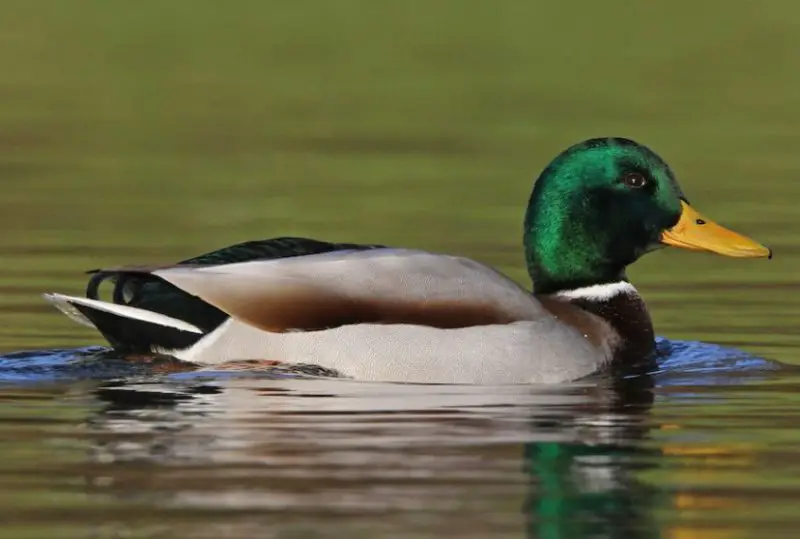
The Mallard (Anas platyrhynchos) is a 23-inch, 2.4-pound duck with a 35-inch wingspan. Males have a metallic green head, yellow bill, and chestnut breast, while females are mottled brown and buff with a dark crown and eye stripe. Both sexes display a green-blue wing patch bordered with white in flight.
They forage for insect larvae, seeds, and grain in shallow water and fields. Females produce a “quack, quack” call. Mallards nest on the ground in grass or under bushes. Found in ponds, marshes, and wetlands across Canada, the USA, and Eurasia, this species is a familiar sight near people.
Killdeer

The Killdeer (Charadrius vociferus) is a 10.5-inch, 3.3-ounce plover with a 24-inch wingspan. It has a dark brown upper body, white underparts, two black breast bands, and a patterned face. Both sexes share a slender black bill, red-orange eyerings, and long pale legs. In flight, its long dark wings show white stripes, and its wedge-shaped orange tail has a black tip. Vocal and common, the Killdeer forages for insects and seeds in open grassy areas, often calling “tideer, tideer, tideer.”
Common Grackle
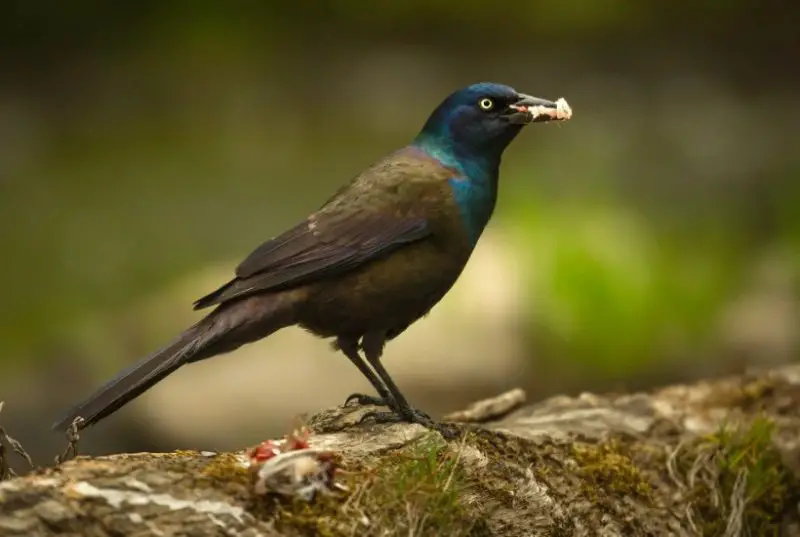
The Common Grackle (Quiscalus quiscula) is a 12.5-inch, 4-ounce bird with a 17-inch wingspan. This jay-sized bird has glossy black plumage with iridescent purple, blue, green, and bronze highlights, pale eyes, and a long, wedge-shaped tail. Both sexes have stout black beaks and strong legs, though females have shorter tails and less iridescence. Common Grackles forage in open habitats, eating insects, seeds, and small animals, and build bulky stick nests in conifers. They are vocal, often calling “Sherink!”
Eastern Bluebird
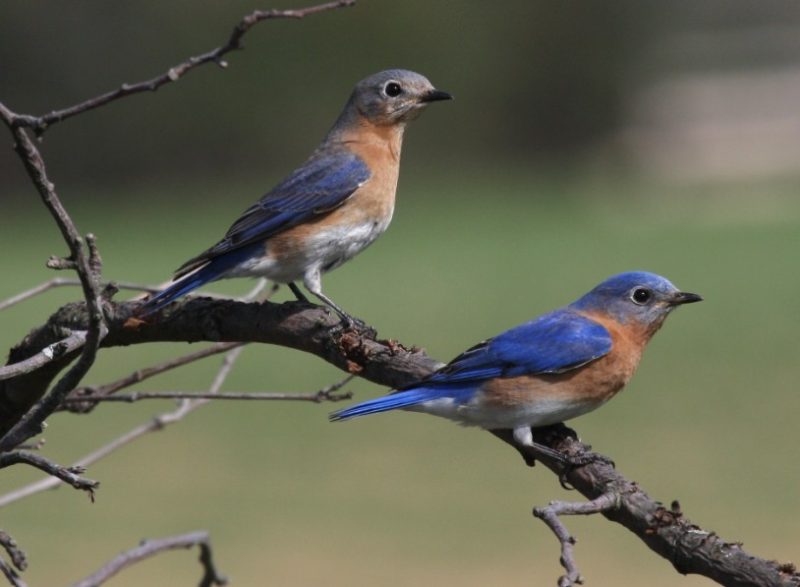
The Eastern Bluebird (Sialia sialis) is a small, 7-inch, 1.1-ounce bird with a 13-inch wingspan. Males have vibrant blue upperparts, orange on the throat and flanks, and a white belly. Females are blue-gray with a white eyering. They forage for insects and fruit, catching insects mid-flight or from the ground. They nest in tree cavities or nest boxes. Known for their melodic song, “fer fer chidip fer,” Eastern Bluebirds thrive in open habitats across southern Canada, the USA, and parts of Mexico.
Barn Swallow
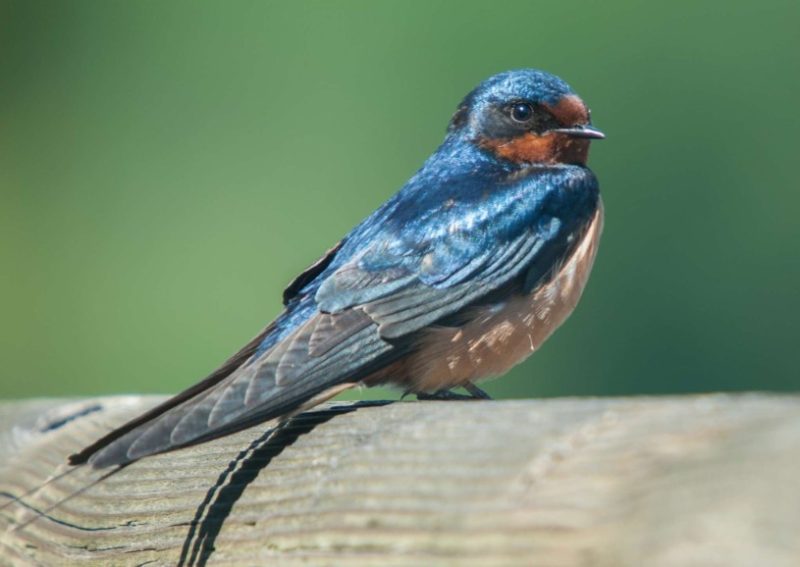
Barn Swallows (Hirundo rustica) are small to medium-sized swallows, 6.75 inches long, weighing .67 ounces, with a 15-inch wingspan. They have dark, steel-blue upperparts, peach-orange underparts, and rich chestnut on the throat. Males and females look similar, but females are paler with shorter tails. These swallows forage for insects mid-flight over fields and open habitats. They build mud cup nests on barns and structures. Their song is a complex “chipchipfitfibitchipfibitfwip.”
Brown-headed Cowbird
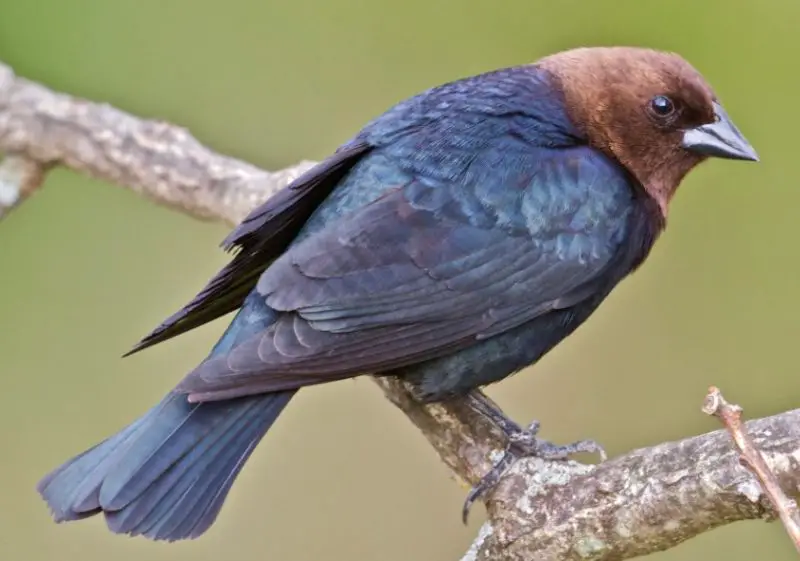
The Brown-headed Cowbird (Momothrus ater) is a 7.5-inch blackbird weighing 1.5 ounces, with a 12-inch wingspan. Males are glossy black with a brown head, while females are dark gray with a white throat. They forage in flocks for seeds and insects on the ground, often near large grazing animals. Cowbirds lay their eggs in other birds’ nests. Males sing a distinctive “qwuipuh see!” song. They thrive in fields, pastures, and open areas.
Ring-billed Gull
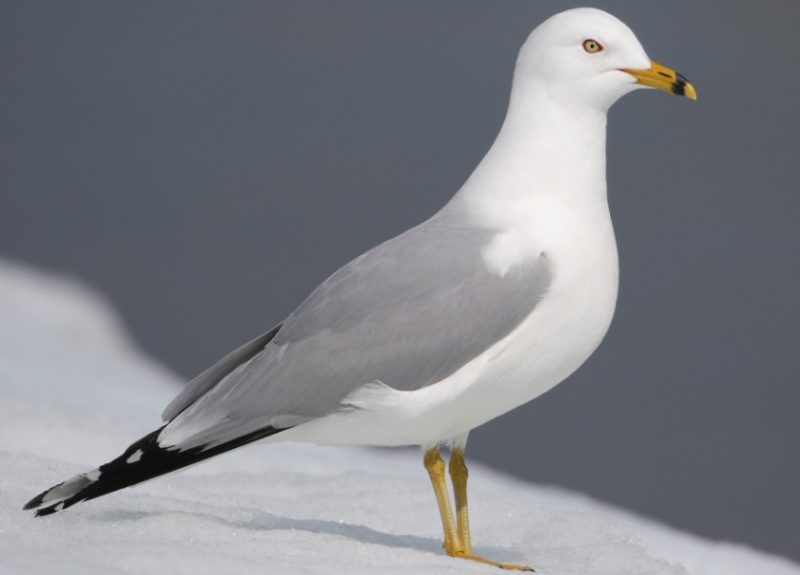
The Ring-billed Gull (Larus delawarensis) is a 17.5-inch gull weighing 1.1 pounds with a 48-inch wingspan. It is pale gray and white with a distinctive black ring on its yellowish beak, yellow legs, and black-tipped wings. Juveniles have pink and black beaks. This opportunistic feeder scavenges for fish, carrion, and other items. Ring-billed Gulls breed in colonies on the ground. Their call is a high-pitched “kleea” and a laughing “KLEE..KLEEE..kleeya,kleeya,kleeya”.
Indigo Bunting
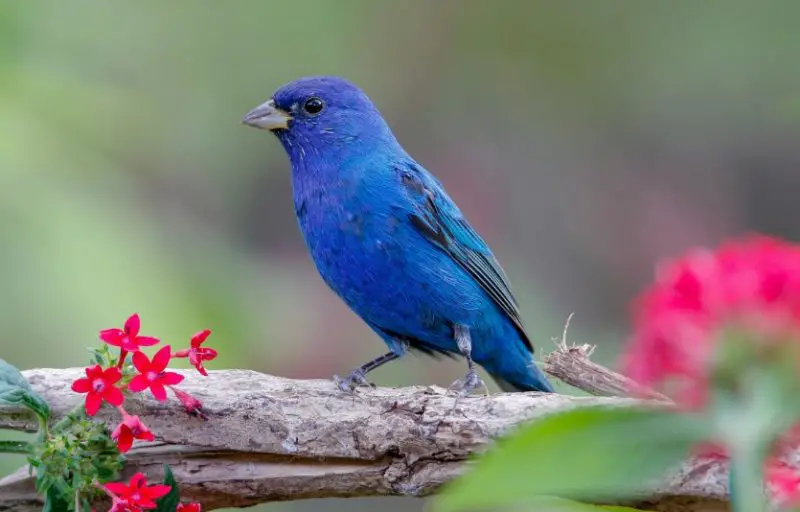
The Indigo Bunting (Passerina cyanea) is a 5.5-inch bird weighing .51 ounces with an 8-inch wingspan. Males are deep, dark blue with black on their face, wings, and tail. Females are pale brown with a white throat and belly, a hint of a buffy eyering, and faint streaks below.
They feed on insects, seeds, and berries, foraging on the ground and in vegetation. Indigo Buntings build open cup nests in shrubs using grass and soft plant matter. Their song is a halting “seet seet, sweet sweet, chip chup, swee sweet” and they often call “Pik!”.
Eurasian Collared-Dove
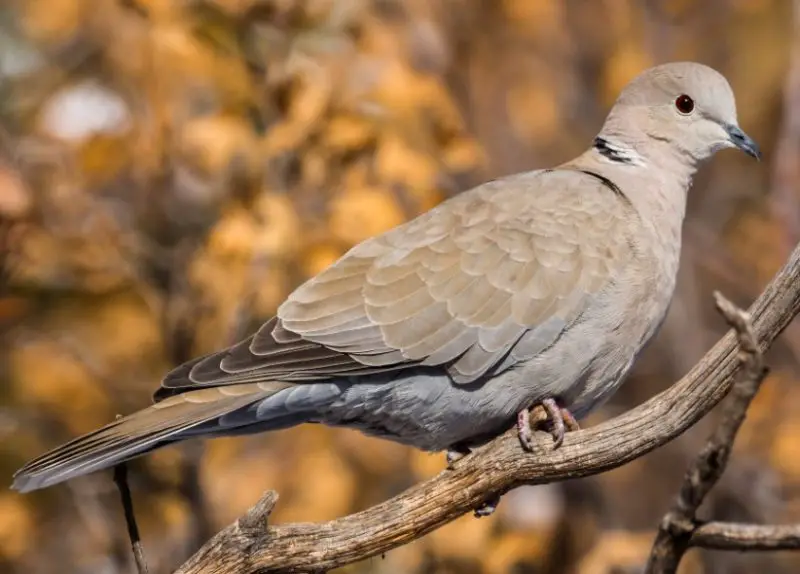
The Eurasian Collared-Dove (Streptopelia decaocto) measures 13 inches, weighing 7 ounces, with a wingspan of 22 inches. Both males and females resemble each other, displaying a pale tan and gray plumage with a black nape mark and slender black beak.
Feeding mainly on grain and seeds found on the ground, they also visit feeders, especially around farms and grain silos. Their nests, made of messy sticks, are commonly found in trees and structures near human habitats. Their distinctive call is a rhythmic “hoo hoo hoowuh hoo WUH hoowuh hoo WUH!”.
Harris’s Sparrow
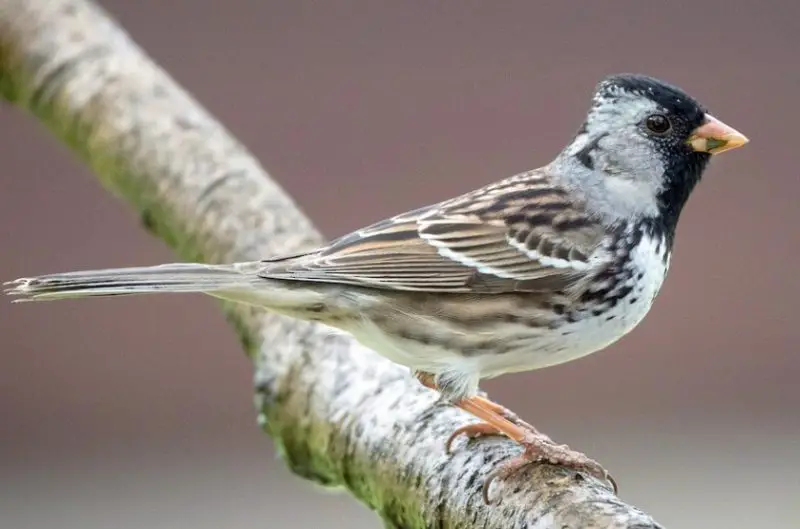
The Harris’s Sparrow (Zonotrichia querula) measures 7.5 inches, weighing 1.3 ounces, with a wingspan of 10.5 inches. Its grosbeak-like appearance includes a conical pink beak and mottled gray and brown feathers, with distinct black markings on the face, throat, and crown.
Feeding on seeds, berries, and insects, it forages on the ground and low vegetation. Its song is a clear, high-pitched “teee tee tee”, accompanied by a short, clinking “tink!” call note. This species breeds in northern Canada’s subarctic boreal forest and winters in the central USA, including Kansas.
Eastern Meadowlark
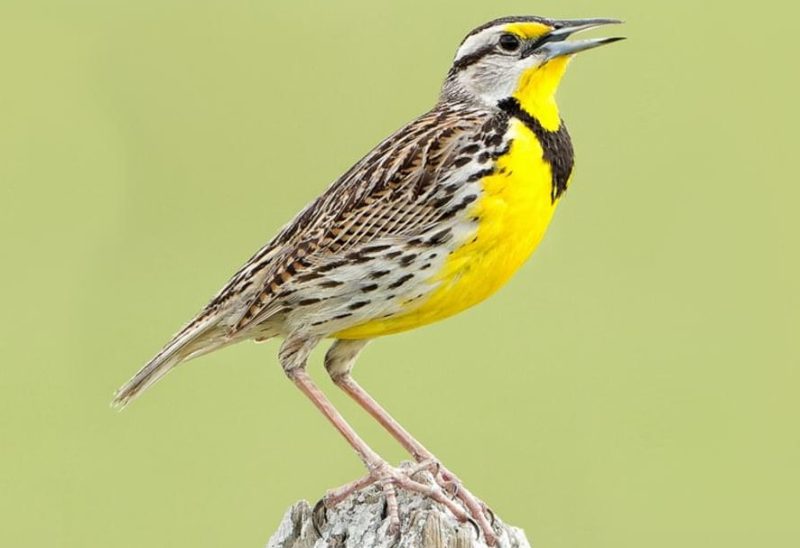
The Eastern Meadowlark (Sturnella magna) is a chunky, robin-sized bird, measuring 9.5 inches and weighing 3.2 ounces, with a wingspan of 14 inches. Sporting mottled pale-brown upperparts, it features a distinctive black “V” mark on its yellow chest.
Foraging mainly for insects and grubs by probing the ground, it nests on the ground in grassy habitats. Its short, melodious song, “two tee tureeah”, distinguishes it. This species is common across southeastern Canada, the eastern USA, and into northern South America, including Kansas.
Baltimore Oriole
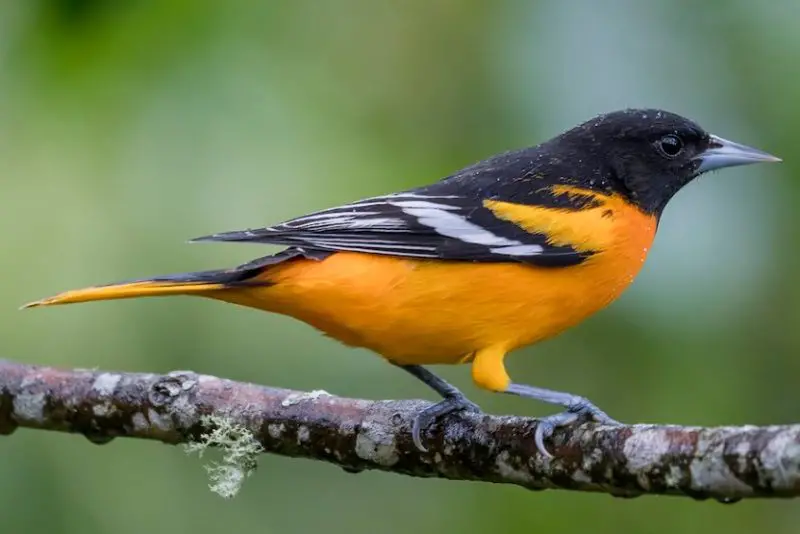
The Baltimore Oriole (Icterus galbula) is a smallish blackbird with a length of 8.75 inches, weighing 1.2 ounces, and a wingspan of 11.5 inches. Males boast rich orange colors on their undersides, shoulders, wings, and tail, contrasting with their black upperparts and head. Females and young birds are duller orange with dark wings and two pale wing bars.
They feast on insects, caterpillars, fruit, and nectar, often visiting feeders for grape jelly. Baltimore Orioles are known for their melodious song, “turee turee tureeturee tureeturree”, and they weave hanging nests made of grass and vegetation. These birds are widespread across much of central and southern Canada, the eastern USA, and are commonly found in Kansas.
Song Sparrow
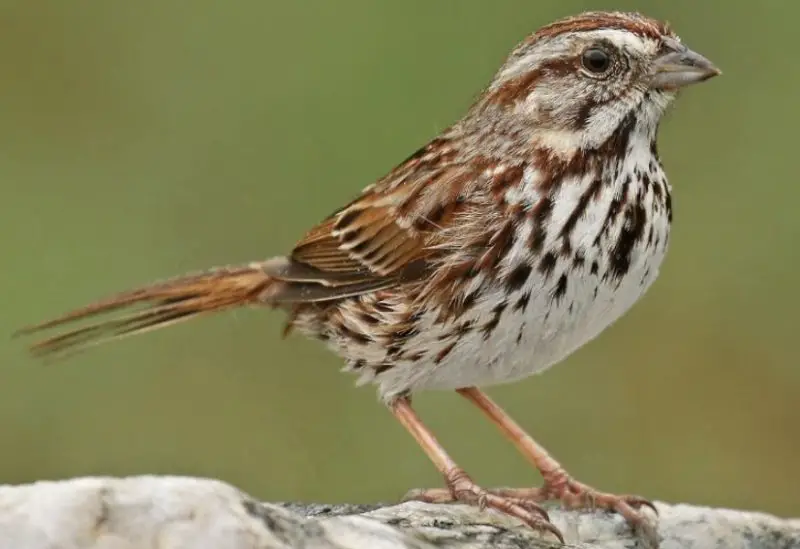
The Song Sparrow (Melospiza melodia) is a small, streaked songbird with a length of 6.25 inches, weighing 0.7 ounces, and a wingspan of 8.25 inches. Both males and females have gray and brown plumage with white underparts adorned with a dark mark on the breast. They boast a cheerful song characterized by a trill, “seet serate sitsziziziziziziziz seet”, and are often found in brushy habitats across southern Alaska, Canada, and the USA.
These sparrows feed on insects, seeds, and small fruits, foraging on the ground and visiting bird feeders for millet. They construct cup nests from grass and stems, typically placed near the ground in shrubbery or low trees.
White-throated Sparrow
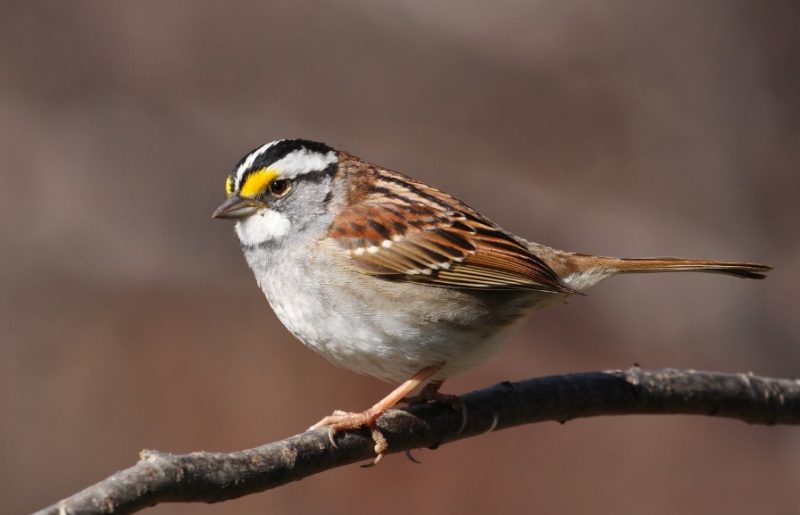
The White-throated Sparrow (Zonotrichia albicollis) is a chunky sparrow, measuring 6.75 inches in length and weighing 0.91 ounces, with a wingspan of 9 inches. Both males and females feature a white throat and distinct black and white or tan stripes on their head. They forage for seeds, insects, and berries on the ground, often scratching away leaves to uncover hidden food.
During breeding season, they construct cup nests using grass, bark, and twigs on the ground beneath dense vegetation. These sparrows migrate to winter in the eastern and southwestern USA, emitting sharp “tink” calls and singing a clear, whistled song reminiscent of “Ohhh Canada Canada Canada” or “Ohhh, Cana, Cana, Cana”.
Eastern Phoebe

The Eastern Phoebe (Sayornis phoebe) is a small to medium-sized flycatcher, measuring 7 inches in length and weighing 0.7 ounces, with a wingspan of 10.5 inches. It has a plain appearance, with dark brownish-gray upperparts and white underparts, along with some gray on its breast. Males and females look alike, while young birds have pale yellow bellies.
Eastern Phoebes feed on insects, snapping them up with their slender beak while perched low or mid-height in woodlands. They also make cup nests of mud, moss, and leaves on rocky outcrops or under bridges. This species breeds in woodlands and parks in Canada and the eastern USA, and winters in similar habitats in the southeastern USA and Mexico. Their distinctive song sounds like their name, “see-BEE! See BIDIT”.
Eastern Kingbird
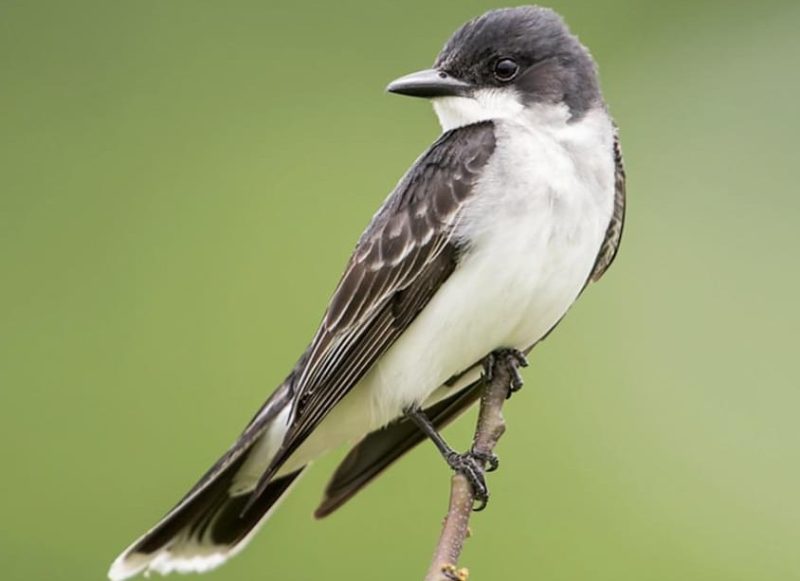
The Eastern Kingbird (Tyrannus tyrannus) is a medium-sized flycatcher, measuring 8.5 inches in length and weighing 1.4 ounces, with a wingspan of 15 inches. It has a distinctive blackish upperparts and white underparts, with males and females appearing identical. One of its key features is the bold white tip on its longish, rectangular tail. Eastern Kingbirds primarily feed on insects and berries, catching bugs in flight by flying from a perch or hovering to pick berries from trees. They construct loose cup nests of grass and twigs in trees.
These birds breed in meadows and open habitats across a large part of Canada, the eastern USA, and parts of western North America, migrating to South America for winter. Their high-pitched calls sound like “sipea sitpipee”.
Great Crested Flycatcher
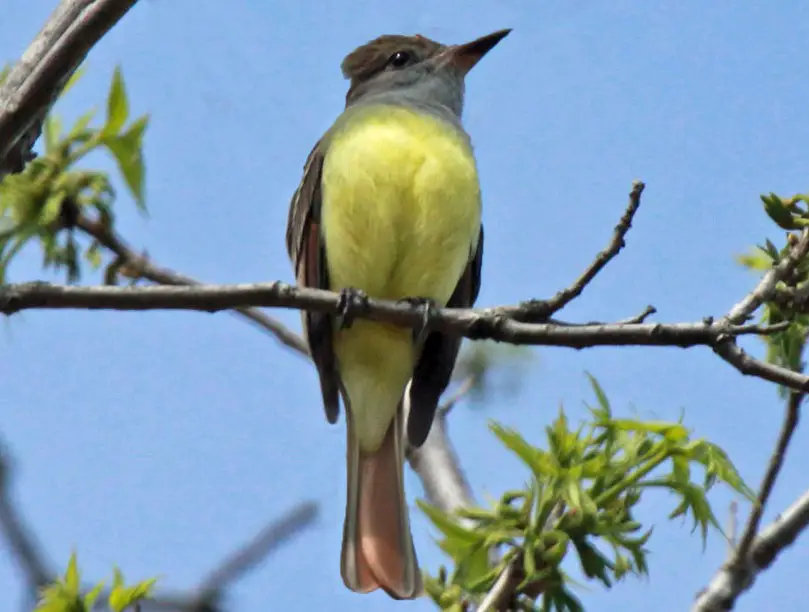
The Great Crested Flycatcher (Myiarchus crinitus) is a medium-sized flycatcher, measuring 8.75 inches in length and weighing 1.2 ounces, with a wingspan of 13 inches. Both males and females have olive-brown upperparts, gray on their face, throat, and breast, and yellow on their lower breast and belly. They also sport two white wing bars, white edging on some wing feathers, and a reddish-brown tail.
These flycatchers primarily feed on insects and small fruits, catching prey in the air, from foliage, or on the ground. They construct soft, shallow cup nests made of moss, grass, and other vegetation inside tree cavities. Breeding in wooded habitats across central and southern Canada and much of the eastern USA, they migrate to tropical regions in southern Florida, the Caribbean, and southern Mexico to Venezuela. Their distinctive call is a short but loud and rising “Wheep!”, accompanied by short “reedy” calls and brief “reep” vocalizations.
Red-headed Woodpecker
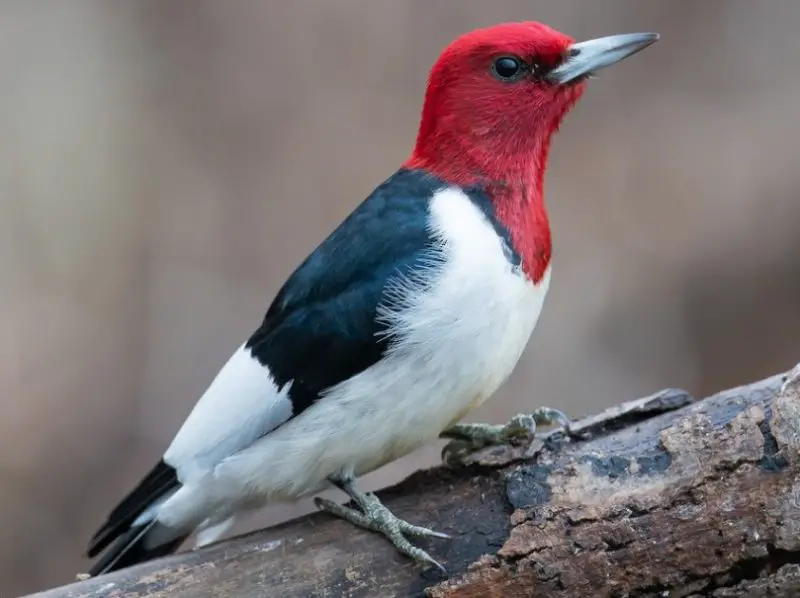
The Red-headed Woodpecker is a striking medium-sized bird known for its bold black-and-white plumage and vibrant red head. Found across southern Canada and the eastern USA, it nests in tree cavities and forages for seeds, nuts, fruit, and insects. With a distinct “kwueeh” call, it displays an undulating flight pattern while catching insects mid-air. This unique woodpecker is the only North American species known to store food items, covering them with wood or bark.

